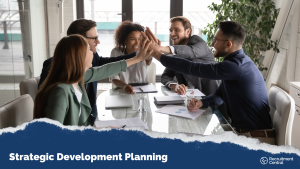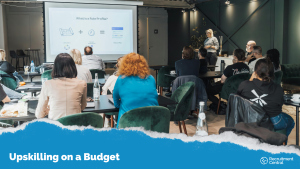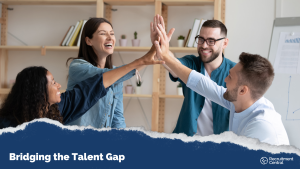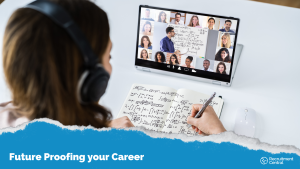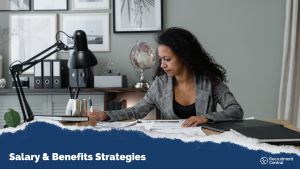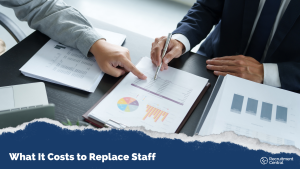Workforce Planning for the Future: A Guide
If you’re not sure where to start when planning how your team should evolve in a fast-changing market, this guide will help you anticipate skill needs, close gaps early, and prepare through structured workforce planning.
With workforce dynamics shifting and AI reshaping the nature of work, how can you build a team that’s ready for what’s next?
In an ever-changing world, one of the key factors that sets high-performing teams apart is their ability to plan ahead. Being able to anticipate future needs and business priorities means you can hire the right people, address skill gaps early, and stay adaptable through change.
While thinking about the future has always been important for businesses aiming to improve their recruitment, this kind of predictability is more critical now than ever. According to the Australian HR Institute, over 70 per cent of Australian employers report difficulty recruiting specialised roles, a challenge expected to grow in coming years.
At the same time, employee turnover rates across Australia are evolving as workplace priorities shift. Organisations without the foresight to predict their future skill needs often find themselves reacting at the last minute to industry changes. On the other hand, businesses that invest in forward-thinking talent strategies position themselves to meet challenges with confidence.
It’s time to embrace the value of planning ahead.
The Predictability Challenge in Australian Employment
In recruitment and workforce planning, being able to foresee your company’s or clients’ future skill requirements can make a real difference. The more insight you have, the better you can respond to shifting customer needs and market trends.
Since 2023, change has accelerated due to technology advances, including AI, and evolving client expectations. The National Skills Commission forecasts that by 2030 nearly 40 per cent of the skills employers prioritise today could become obsolete. This makes skill forecasting both more important and more challenging.
Poor predictability often leads to scrambling for the right talent at the last minute, which can result in higher costs and project delays. It can also negatively impact employee engagement and retention, as overstretched teams face burnout.
Quick Recap so far:
• Planning ahead helps you hire smarter and avoid last-minute scrambles.
• Skill forecasting is more critical than ever with AI and shifting markets.
• Poor predictability leads to higher costs, delays and burnout.
Why Skill Forecasting Matters for Your Business
Looking ahead when it comes to workforce planning, it isn’t just about avoiding pitfalls – it’s a smart move that gives your business a competitive edge.
When you anticipate staffing needs early, you can fill gaps through strategic hiring or upskilling before they affect performance or employee wellbeing.
Effective skills forecasting can:
- Reduce Hiring Costs: Proactively identifying gaps avoids expensive last-minute recruitment or temporary hires.
- Keep Projects on Track: Having the right skills in place speeds up delivery and improves client satisfaction.
- Boost Employee Engagement: Balanced workloads mean less burnout and higher productivity.
- Enhance Client Trust: Being prepared with skilled professionals helps you meet client expectations consistently.
- Lower Turnover: Employees with the right skills and manageable workloads tend to stay longer.
Overall, planning ahead helps minimise turnover, improve productivity, keep customers happy, and support growth.
Practical Ways to Improve Your Skill Forecasting
How do you effectively anticipate future skill needs when roles change rapidly and flexible work reshapes priorities? Here are some strategies that work well in today’s Australian context:
1. Analyse Your Project Pipeline
What projects are underway or coming soon? Understanding your workload helps pinpoint which skills will be essential. For example, if many projects require strong data analysis, prioritise hiring or training in that area. Keep regular conversations with clients and review sales data to stay informed about upcoming challenges.
2. Monitor Industry Trends and Plan Scenarios
Stay updated on technology developments, regulatory changes, and market shifts affecting your sector. AI adoption is increasing the demand for digital literacy and related skills across many industries. Try scenario planning (mapping out potential futures and what skills each might require) to focus your efforts wisely.
3. Maintain a Skills Inventory and Assess Gaps
Keep detailed records of your team’s current skills through resumes, role descriptions, and assessments. Look at past projects to see which skills contributed most to success. This approach helps identify gaps and informs recruitment or training decisions.
4. Use AI Tools for Insight
AI-driven tools can provide valuable insights into market trends and skill demands, complementing your forecasting efforts.
How to Build a Culture that Supports Predictability
- Break Down Silos: Encourage open communication across departments to share skills data and insights. When teams work in isolation, it’s harder to keep track of skills or spot opportunities. Make sure leaders and supervisors regularly share updates about their team’s strengths and challenges.
- Create Feedback Loops: Set up regular feedback from client-facing and project teams. Find out where they’re hitting roadblocks or inefficiencies. Listen to what clients, both happy and unhappy, say about your service to spot areas for improvement.
- Regularly Review Skill Forecasting: Keep your forecasting approach up to date with market shifts and industry trends. Check if you’re factoring in new technology, changing team structures, or evolving business needs.
- Establish Early Warning Systems: Track key indicators and market trends so you can identify skill shortages early. Have a plan ready for quick responses, such as targeted training or strategic hiring, before any gaps impact your team.
- Develop Flexible Talent Strategies: Don’t rely only on hiring new staff when skill gaps appear. Consider contractors, interim roles, partnerships, or upskilling current employees. Mentoring programmes help pass on vital skills from experienced workers to others.
- Encourage Continuous Learning: Build a culture where learning is ongoing and valued. Support your team with courses, workshops, and micro-credentials. Ask employees which skills they want to develop; this boosts motivation and aligns personal growth with business goals.
Embracing Planning for a Stronger Future
The Australian workplace continues to change quickly. By focusing on skill forecasting now, you’ll be better placed to adapt and thrive.
Being proactive means fewer surprises, less stress on your team, happier clients, and a healthier bottom line.
At Recruitment Central, we help you with workforce planning to forecast future skills needs, identify gaps, and find talent who can grow with you. Let’s build your workforce of the future with smart workforce planning today.
Sources & Further Reading:
• Australian HR Institute (AHRI) — Workforce and Skills Reports
• Australian Bureau of Statistics (ABS) — Labour Force Survey and Workplace Trends
• National Skills Commission (NSC) — Skill Shortages and Projections
• Fair Work Commission — Employment and Turnover Data
• Safe Work Australia — Workplace Health, Burnout, and Absence Statistics
• Australian Digital Inclusion Index — Digital Skills and Inclusion Reports
Read this first: If you’re hiring now and want a partner who delivers real results, start with Recruitment Central – Your Global Partner. Learn how we use our global network, industry insight and tailored solutions to find the right people, fast.



